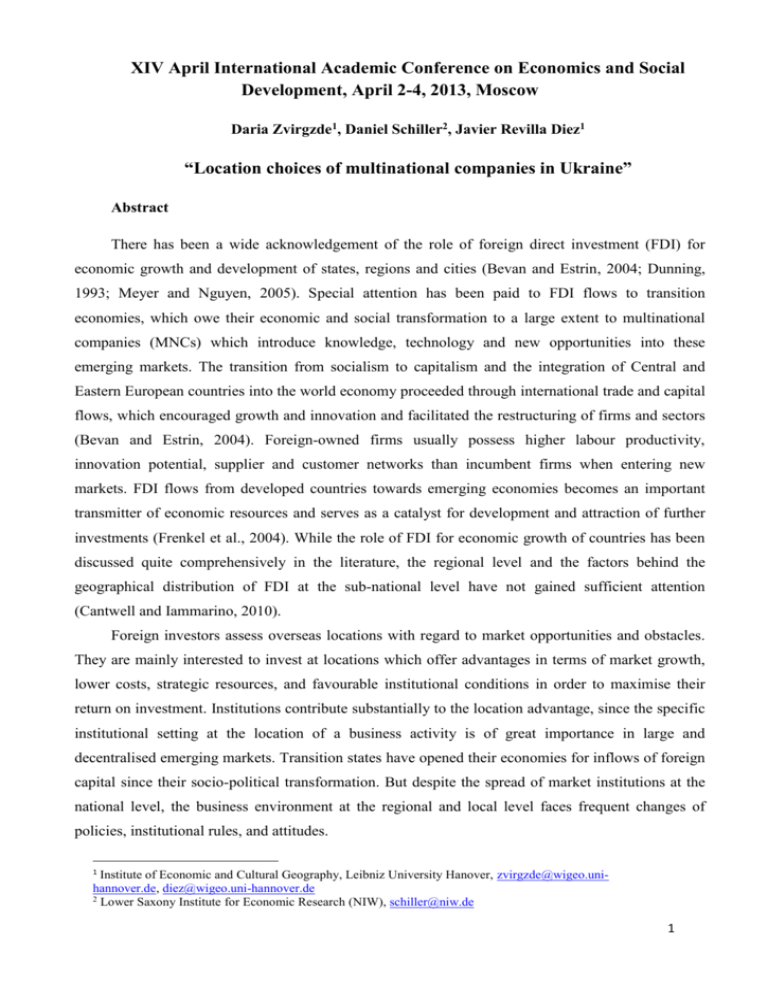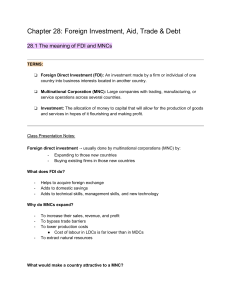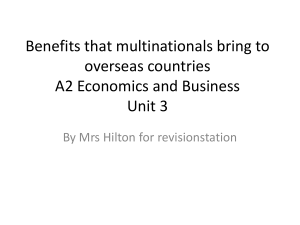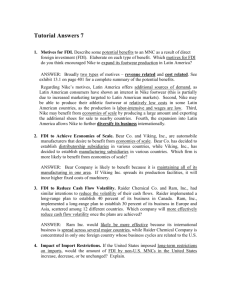Location choices of multinational companies in Ukraine
advertisement

XIV April International Academic Conference on Economics and Social Development, April 2-4, 2013, Moscow Daria Zvirgzde1, Daniel Schiller2, Javier Revilla Diez1 “Location choices of multinational companies in Ukraine” Abstract There has been a wide acknowledgement of the role of foreign direct investment (FDI) for economic growth and development of states, regions and cities (Bevan and Estrin, 2004; Dunning, 1993; Meyer and Nguyen, 2005). Special attention has been paid to FDI flows to transition economies, which owe their economic and social transformation to a large extent to multinational companies (MNCs) which introduce knowledge, technology and new opportunities into these emerging markets. The transition from socialism to capitalism and the integration of Central and Eastern European countries into the world economy proceeded through international trade and capital flows, which encouraged growth and innovation and facilitated the restructuring of firms and sectors (Bevan and Estrin, 2004). Foreign-owned firms usually possess higher labour productivity, innovation potential, supplier and customer networks than incumbent firms when entering new markets. FDI flows from developed countries towards emerging economies becomes an important transmitter of economic resources and serves as a catalyst for development and attraction of further investments (Frenkel et al., 2004). While the role of FDI for economic growth of countries has been discussed quite comprehensively in the literature, the regional level and the factors behind the geographical distribution of FDI at the sub-national level have not gained sufficient attention (Cantwell and Iammarino, 2010). Foreign investors assess overseas locations with regard to market opportunities and obstacles. They are mainly interested to invest at locations which offer advantages in terms of market growth, lower costs, strategic resources, and favourable institutional conditions in order to maximise their return on investment. Institutions contribute substantially to the location advantage, since the specific institutional setting at the location of a business activity is of great importance in large and decentralised emerging markets. Transition states have opened their economies for inflows of foreign capital since their socio-political transformation. But despite the spread of market institutions at the national level, the business environment at the regional and local level faces frequent changes of policies, institutional rules, and attitudes. 1 Institute of Economic and Cultural Geography, Leibniz University Hanover, zvirgzde@wigeo.unihannover.de, diez@wigeo.uni-hannover.de 2 Lower Saxony Institute for Economic Research (NIW), schiller@niw.de 1 The factors that attract MNCs towards certain markets and economies are unevenly distributed among countries and regions. While some regions are clearly benefitting from attractive initial conditions, which pull in foreign investment that further fosters the transition process, regions which do not have such favourable conditions lag behind and perform relatively poor (Barrell and Pain, 1999). Thus, the regional variation in the institutional environment at different locations represents an important extension of the original reasoning about foreign firms choosing specific markets (Meyer and Nguyen, 2005). This is of even bigger importance for countries which share a border with the European Union (EU) and are not yet the members of the EU, but part of the European Neighbourhood Policy (ENP). It is supposed that geographical distance to the EU border has an impact on the institutional quality and, thus, the investment decisions of MNCs. An advantageous position of regions closer to the border and capital regions is expected. The range of specific host region determinants for the attraction of FDI is generally divided into two broad groups: traditional economic factors and institutional factors (Frenkel et al., 2004; Bevan et al., 2004; Kang and Jiang, 2012). Traditional economic factors are based on the systematic conceptualisation of FDI location choices by Dunning (1993) in his eclectic paradigm OLI, which stands for ownership, location and internalisation advantages. The importance of specific traditional location factors attracting FDI according to Dunning depends on the motives of the investor, namely natural resource seeking, market seeking, efficiency seeking and strategic asset seeking. Based on these motives, the paper will describe a broad range of region specific economic factors, such as costrelated parameters, market-related factors, availability of local knowledge and technology, and agglomeration forces that all have a significant impact on the propensity of MNCs to invest abroad. The relevance of the institutional perspective for location choices of MNCs has gained a much wider audience recently. It focuses explicitly on the embeddedness of firms into local institutional environments (Kostova and Zaheer, 1999). Foreign firms become highly dependent on the institutional factors at the chosen location for investment and have to adapt themselves (at least to a certain degree) to the local institutional framework in order to gain legitimacy and integration within the regional economic system (Kang and Jiang, 2012). FDI from developed into developing countries depends even more on institutional parameters, since developed country MNCs are used to a business environment shaped by a set of rather complete market-based institutions in their home markets. Nevertheless, these MNCs are often big players in their industry and have the power to shape institutional contexts in the host country due to their large size, superior capabilities and dominant position in global value chains. Thus, an interdependent perspective on institutional quality, location choices of MNC, and institutional change is needed. The aim of the paper is to identify determinants of location choices of FDI in transition economies, based on empirical evidence of an enterprise survey carried out in three regions in 2 Ukraine within the project “SEARCH: Sharing knowledge assets: interregionally cohesive neighbourhoods” funded by the European Union within the Seventh Framework Programme for Research (FP7). The conceptual framework of the paper deals not only with place specific characteristics of the receiving country, but takes a broader look at the motives of foreign firms to invest in local capabilities in the host region. The results of the survey will also uncover important issues of initial aims of MNCs, their strategic orientation, propensity to innovate and upgrade in the host market, cooperation with domestic suppliers and customers, and development of the human capital base in the host region. This approach will provide a comprehensive picture of patterns of location decisions for FDI in transition economies and more specifically in Ukraine. By and large, the paper contributes to the provision of a thorough theoretical framework on location choices of MNCs by integrating the institutional component and provides empirical results on (1) traditional economic factors that attract FDI to certain localities within transition economies, specifically Ukraine, (2) institutional parameters of regions that attract or distract MNCs in order to determine the impact of the institutional environment on the propensity of foreign firms to invest in certain host markets, and (3) the embeddedness of MNCs within regional economic systems and their contribution to innovation and upgrading. References Barrell, R. and Pain, N. (1999): European growth and integration: domestic institutions, agglomerations and foreign direct investment in Europe. European Economic Review, pp. 925 -935. Bevan , A., Estrin, S. And Meyer, K.E. (2004): Foreign Investment Location and Institutional Development in Transition Economies. International Business Review, 13, pp. 43-64. Bevan, A.A. and S. Estrin (2004): The determinants of foreign direct investment into European transition economies. Journal of Comparative Economics, 32 (4), pp. 775-787. Cantwell, J. And Iammarino, S. (2000): Multinational Corporations and the Location of Technological Innovation in the UK Regions. Regional studies, 24 (4), pp. 317-332. Dunning, J.H. (1993): Multinational Enterprises and the Global Economy. Wokingham: Addison-Wesley. Frenkel, M., Funke, K. And Stadtmann, G. (2004): A panel analysis of bilateral FDI flows to emerging economies. Economic System, 28, pp. 281-300. Kang, Y. and Jiang, F. (2012): FDI location choice of Chinese multinationals in East and Southeast Asia: Traditional economic factors and institutional perspective. Journal of World Business, 47, pp. 45-53. Kostova, T. and Zaheer, S. (1999): Organizational Legitimacy under Conditions of Complexity: the Case if the Multinational Enterprise. Academy of Management Review, 24(1), pp. 64-81. Meyer, K. and Nguyen H.V. (2005): Foreign Investment Strategies and Sub-national Institutions in Emerging Markets: Evidence from Vietnam. Journal of Management Studies, 42 (1), pp. 63-93. 3











